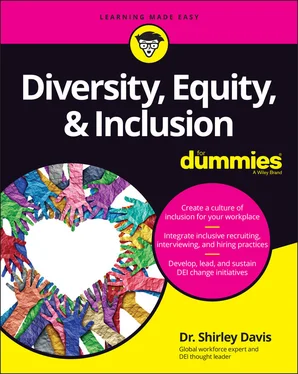Dr. Shirley Davis - Diversity, Equity & Inclusion For Dummies
Здесь есть возможность читать онлайн «Dr. Shirley Davis - Diversity, Equity & Inclusion For Dummies» — ознакомительный отрывок электронной книги совершенно бесплатно, а после прочтения отрывка купить полную версию. В некоторых случаях можно слушать аудио, скачать через торрент в формате fb2 и присутствует краткое содержание. Жанр: unrecognised, на английском языке. Описание произведения, (предисловие) а так же отзывы посетителей доступны на портале библиотеки ЛибКат.
- Название:Diversity, Equity & Inclusion For Dummies
- Автор:
- Жанр:
- Год:неизвестен
- ISBN:нет данных
- Рейтинг книги:3 / 5. Голосов: 1
-
Избранное:Добавить в избранное
- Отзывы:
-
Ваша оценка:
- 60
- 1
- 2
- 3
- 4
- 5
Diversity, Equity & Inclusion For Dummies: краткое содержание, описание и аннотация
Предлагаем к чтению аннотацию, описание, краткое содержание или предисловие (зависит от того, что написал сам автор книги «Diversity, Equity & Inclusion For Dummies»). Если вы не нашли необходимую информацию о книге — напишите в комментариях, мы постараемся отыскать её.
Diversity, Equity & Inclusion For Dummies,
Diversity, Equity & Inclusion For Dummies
Diversity, Equity & Inclusion For Dummies — читать онлайн ознакомительный отрывок
Ниже представлен текст книги, разбитый по страницам. Система сохранения места последней прочитанной страницы, позволяет с удобством читать онлайн бесплатно книгу «Diversity, Equity & Inclusion For Dummies», без необходимости каждый раз заново искать на чём Вы остановились. Поставьте закладку, и сможете в любой момент перейти на страницу, на которой закончили чтение.
Интервал:
Закладка:
Similar to implicit bias, microaggressions are an unfortunate outcome of the human experience. Check out the discussion of microaggressions in Chapter 7to help to raise your consciousness about these matters and how to mitigate them.
Neurodiversity
The concept of neurodiversity is newer in the DEI space but not the medical and social science fields. Neurodiversity is a term that was introduced in 1998 by an autistic sociologist named Judy Singer. It comes from a number of brain studies that reveal that people who think, learn, and process information differently than others have brains that are wired that way. Advocates seek to set the record straight that people who are neurodiverse are not suffering from a disease or dysfunction. Rather, the idea is that people should expand their understanding of what’s “normal” in terms of brain function — that many things that have been considered problems are actually just differences.
Neurodiversity is important for the workplace because often those who are considered neurodiverse fall under the disability umbrella; however, John Elder Robison, a neuroscience scholar in residence at the College of William & Mary in Williamsburg, Virginia stated that “neurodiversity is the idea that neurological differences like autism and ADHD are the result of normal, natural variation within the human genome.” Neurodiverse people’s brains function outside the average brain and have the ability to hyper-focus, which is beneficial in certain job categories and industries.
Prejudice and stereotypes
A stereotype is a widely held but fixed and oversimplified image or idea of a particular type of person, thing, or group. Prejudice is an attitude or feeling of unfair dislike based mostly on opinions and stereotypes rather than facts and evidence because of some characteristic such as race, age, religion, and so on.
Stereotypes are any commonly known public belief about a certain social group or a type of individual. They can be positive (for example, most people assume that all millennials are tech-savvy). Prejudices, on the other hand, are almost always negative and aren’t based on reason or experience. They often are supported by a belief that certain people or groups have less worth or fewer abilities. Prejudiced behavior is often influenced by bias.
Stereotypes are often believed and perpetuated out of humans’ need to believe a generalized assumption about a group they don’t normally interact with. Stereotyping and prejudiced behavior (that is, discrimination) often go hand in hand because prejudices are often based on believing stereotypes. Discrimination, then, is negative, destructive, and exclusionary behavior toward an individual or groups of people based on identity groups (such as race, gender, sex, ethnicity, or social class). Prejudice and stereotypes are perpetuated through discrimination at the individual, institutional, and structural level, and discrimination is put into practice through personal behaviors, practices, cultures, laws, and policies.
Think for a moment about your own experiences with stereotypes. What stereotypes were you taught growing up? What messages did you receive about your group? What messages did you receive about people who are different from you?
Privilege and power
Privilege is advantages, rewards, or benefits given to those in the dominant group solely because of their membership in that group. It operates on personal, interpersonal, cultural, and institutional levels and gives these advantages at the expense of members of target groups. In the United States, privilege is granted to people who have membership in one or more of these social identity groups:
White people
Able-bodied people
Heterosexuals
Males
Christians
Middle- or owning-class people
Middle-aged people
English-speaking people
 Privilege is characteristically invisible to people who have it. People in dominant groups often believe that they’ve earned the privileges they enjoy or that everyone could have access to these privileges if only they worked to earn them. In fact, privileges are unearned, and they’re granted to people in the dominant groups regardless of whether they want those privileges, and regardless of their stated intent.
Privilege is characteristically invisible to people who have it. People in dominant groups often believe that they’ve earned the privileges they enjoy or that everyone could have access to these privileges if only they worked to earn them. In fact, privileges are unearned, and they’re granted to people in the dominant groups regardless of whether they want those privileges, and regardless of their stated intent.
Power refers to the capacity to exercise control over others, deciding what’s best for them and who will or won’t have access to resources.
Associated with power are the following terms often used to define social groups that society has afforded more or less power (more/less access):
Marginalized/oppressed/disadvantaged: Social groups with less power, access, or privilege; social groups that have been disenfranchised, made to be invisible, dehumanized, marginalized, and/or exploited
Dominant/privileged/advantaged: Social groups with more power, access, and privilege; social groups who have the ability navigate the world without consequence because of unearned advantages at the expense of folks who are marginalized
 Having a leadership role means you’re the steward of other people’s experiences. As a leader, take a good look at what privilege means for and benefits you. Examining your privilege can be hard, but good leaders have to welcome that discomfort.
Having a leadership role means you’re the steward of other people’s experiences. As a leader, take a good look at what privilege means for and benefits you. Examining your privilege can be hard, but good leaders have to welcome that discomfort.
Getting Started: Reflection Activity
I open this chapter discussing the reality that all of us are on the DEI journey at different stages and phases. Now that you’ve read through this chapter, reflect on three things. First, which phase/stage of your DEI journey do you believe you are in? Choose one of the stages described here or. if it’s not accurately depicted, describe it yourself under number 5.
1 You’ve been on the DEI journey more than 30 years and still feel ill-equipped to work effectively across differences.
2 You just recently started your journey within the last 24 months and find yourself asking the question, “Why didn’t I see this before?” referring to the history of inequities, social injustice, and the many aspects of diversity.
3 You’ve been advocating and practicing this work for decades and still believe we have a long way to go in achieving equity and inclusion.
4 You don’t see the value of DEI work and believe that it’s a distraction in the workplace and that you have no role to play in implementing it.
5 __________________________________________________________________________________
Second, based on the answer you just selected, identify one to two actions you can take to advance on your DEI journey.
Third, think about where your organization is currently on its DEI journey. How would you rate them and why?
You did it! You got through the first chapter. I know that it’s a lot to take in and a lot to comprehend, but now you have a good foundation in which to build your knowledge. I hope you’re ready to take a journey toward a deeper understanding of the comprehensive and complex nature of DEI work. The rest of this book explores the changing workforce demographics and how they’re redefining the workplace, the work, and how work gets done. As a leader, you discover what skills and competencies you need in order to recruit, engage, and retain the new generation of talent. A lot of DEI work still needs to be done, and leaders have a significant role to play in supporting, implementing, and leading DEI initiatives across their organization.
Читать дальшеИнтервал:
Закладка:
Похожие книги на «Diversity, Equity & Inclusion For Dummies»
Представляем Вашему вниманию похожие книги на «Diversity, Equity & Inclusion For Dummies» списком для выбора. Мы отобрали схожую по названию и смыслу литературу в надежде предоставить читателям больше вариантов отыскать новые, интересные, ещё непрочитанные произведения.
Обсуждение, отзывы о книге «Diversity, Equity & Inclusion For Dummies» и просто собственные мнения читателей. Оставьте ваши комментарии, напишите, что Вы думаете о произведении, его смысле или главных героях. Укажите что конкретно понравилось, а что нет, и почему Вы так считаете.












